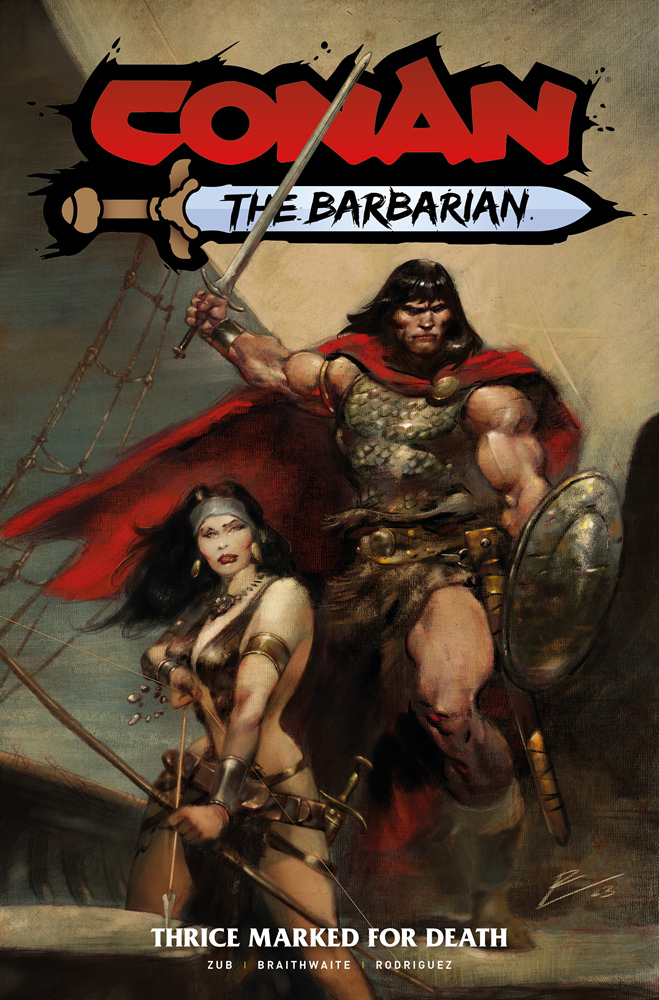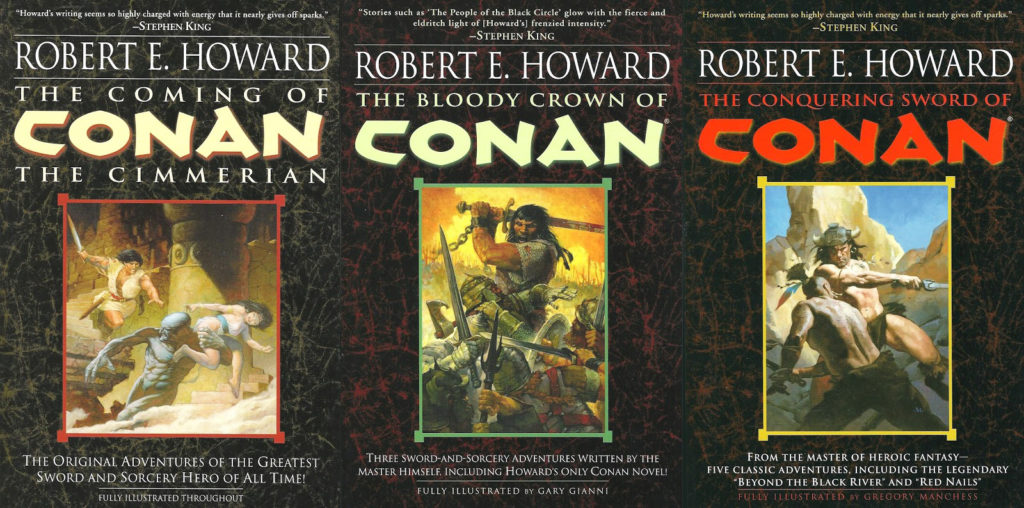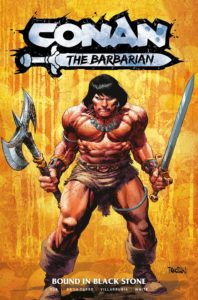
Continuing my Conan reread for Cimmerian September, the ninth published Conan story is Queen of the Black Coast, which arrived in the May 1934 issue of Weird Tales magazine.
Each chapter of this story opens with a verse from “The Song Of Bêlit” which subtly gives the events to come more weight and pathos.
Believe green buds awaken in the spring,
That autumn paints the leaves with somber fire;
Believe I held my heart inviolate
To lavish on one man my hot desire.
—’The Song Of Bêlit’
Chapter one kicks off energetically with a chase in the coastal city of Argos. Conan is on the run from the law and, after heading to the pier, makes a dangerous jump to a trading ship leaving port. He negotiates joining this crew with a lot more intensity than we saw in Pool of the Black One, a story which takes place later in his adventuring career:
“Get under way!” roared the intruder with a fierce gesture that spattered red drops from his broadsword.
“But we’re bound for the coasts of Kush!” expostulated the master.
“Then I’m for Kush! Push off, I tell you!” The other cast a quick glance up the street, along which a squad of horsemen were galloping; far behind them toiled a group of archers, crossbows on their shoulders.
“Can you pay for your passage?” demanded the master.
“I pay my way with steel!” roared the man in armor, brandishing the great sword that glittered bluely in the sun. “By Crom, man, if you don’t get under way, I’ll drench this galley in the blood of its crew!”
But things soon calm down as Argos is left behind. The trading ship can use some muscle and Conan can certainly offer that.
That night, the Cimmerian talks about the circumstances that sent him running from Argos:
“Well, last night in a tavern, a captain in the king’s guard offered violence to the sweetheart of a young soldier, who naturally ran him through. But it seems there is some cursed law against killing guardsmen, and the boy and his girl fled away. It was bruited about that I was seen with them, and so today I was haled into court, and a judge asked me where the lad had gone. I replied that since he was a friend of mine, I could not betray him. Then the court waxed wroth, and the judge talked a great deal about my duty to the state, and society, and other things I did not understand, and bade me tell where my friend had flown. By this time I was becoming wrathful myself, for I had explained my position.
“But I choked my ire and held my peace, and the judge squalled that I had shown contempt for the court, and that I should be hurled into a dungeon to rot until I betrayed my friend. So then, seeing they were all mad, I drew my sword and cleft the judge’s skull; then I cut my way out of the court, and seeing the high constable’s stallion tied near by, I rode for the wharfs, where I thought to find a ship bound for foreign ports.”
The matter-of-fact way Conan relates cause and effect is both amusing and insightful:
Of course the guard had to die for threatening someone’s lover.
Of course Conan would not betray a friend’s trust.
Of course Conan had to kill the judge who tried to imprison him.
It’s another example of Howard’s thoughts on ‘Civilization VS Savagery’ and the difference between written law and moral justice.
The captain is no fan of courts and kings either, so he lets Conan stay and, over the next few paragraphs Howard confidently lays out a coastal journey filled with locations and details that makes the Hyborian Age feel like it exists well beyond the printed page:
They sighted the coast of Shem—long rolling meadowlands with the white crowns of the towers of cities in the distance, and horsemen with blue- black beards who sat their steeds along the shore and eyed the galley with suspicion. She did not put in; there was scant profit in trade with the sons of Shem.
Nor did master Tito pull into the broad bay where the Styx river emptied its gigantic flood into the ocean, and the massive black castles of Khemi loomed over the blue waters. Ships did not put unasked into this port, where dusky sorcerers wove awful spells in the murk of sacrificial smoke mounting eternally from blood-stained altars where naked women screamed, and where Set, the Old Serpent, arch-demon of the Hyborians but god of the Stygians, was said to writhe his shining coils among his worshippers.
Master Tito gave that dreamy glass-floored bay a wide berth, even when a serpent-prowed gondola shot from behind a castellated point of land, and naked dusky women, with great red blossoms in their hair, stood and called to his sailors, and posed and postured brazenly.
The captain isn’t afraid of any kingdom. His only fear is being raided by a ship called the Tigress, captained by a fearsome pirate named Bêlit:
“The wildest she-devil unhanged. Unless I read the signs awrong, it was her butchers who destroyed that village on the bay. May I some day see her dangling from the yard-arm! She is called the queen of the black coast. She is a Shemite woman, who leads black raiders. They harry the shipping and have sent many a good tradesman to the bottom.”
Bêlit is an iconic character in Conan lore and she’s been illustrated many times in many styles. Becky Cloonan‘s version in the Dark Horse comic run is impressively creepy, especially in this early part of the story where her reputation is being built up:

Moments later, the Tigress indeed appears and their ship is under attack. Arrows are launched between the two ships until they get into boarding range, and then things get intensely bloody:
A tall corsair, bounding over the rail, was met in midair by the Cimmerian’s great sword, which sheared him cleanly through the torso, so that his body fell one way and his legs another. Then, with a burst of fury that left a heap of mangled corpses along the gunwales, Conan was over the rail and on the deck of the Tigress.
In an instant he was the center of a hurricane of stabbing spears and lashing clubs. But he moved in a blinding blur of steel. Spears bent on his armor or swished empty air, and his sword sang its death-song. The fighting- madness of his race was upon him, and with a red mist of unreasoning fury wavering before his blazing eyes, he cleft skulls, smashed breasts, severed limbs, ripped out entrails, and littered the deck like a shambles with a ghastly harvest of brains and blood.
The crew of the trading ship gets slaughtered so Conan is alone, armored up and raging with barbarian fury, killing as many raiders as he can before certain death…until Bêlit halts the attack:
She was untamed as a desert wind, supple and dangerous as a she-panther. She came close to him, heedless of his great blade, dripping with blood of her warriors. Her supple thigh brushed against it, so close she came to the tall warrior. Her red lips parted as she stared up into his somber menacing eyes.
“Who are you?” she demanded. “By Ishtar, I have never seen your like, though I have ranged the sea from the coasts of Zingara to the fires of the ultimate south. Whence come you?”
And, within a few swaggering paragraphs, Bêlit is deeply smitten with the barbarian and offers him a place by her side, which he accepts, kicking off a blood-soaked romance for the ages.
Chapter two opens with a montage of Conan aboard the Tigress and their pirate adventures, a sequence that spans years:
The Tigress ranged the sea, and the villages shuddered. Tomtoms beat in the night, with a tale that the she-devil of the sea had found a mate, an iron man whose wrath was as that of a wounded lion. And survivors of butchered Stygian ships named Bêlit with curses, and a white warrior with fierce blue eyes; so the Stygian princes remembered this man long and long, and their memory was a bitter tree which bore crimson fruit in the years to come.
But the heart of Chapter 2 centers around Bêlit’s desire to venture upriver to a mysterious civilization rumored to be flush with treasure. With Conan at her side and so many victories behind them, she thinks they’re invincible.
There’s an extended sequence with Conan and Bêlit on the deck discussing life, the gods, and their love. It’s jam-packed with quotable sections, but the most famous ones are Conan’s pronouncement:
“Let me live deep while I live; let me know the rich juices of red meat and stinging wine on my palate, the hot embrace of white arms, the mad exultation of battle when the blue blades flame and crimson, and I am content. Let teachers and priests and philosophers brood over questions of reality and illusion. I know this: if life is illusion, then I am no less an illusion, and being thus, the illusion is real to me. I live, I burn with life, I love, I slay, and am content.”
And Bêlit’s fierce declaration:
“My heart is welded to your heart, my soul is part of your soul! Were I still in death and you fighting for life, I would come back from the abyss to aid you — aye, whether my spirit floated with the purple sails on the crystal sea of paradise, or writhed in the molten flames of hell! I am yours, and all the gods and all their eternities shall not sever us!”
When it comes to emotionally-charged pulp writing, it doesn’t get any better than that. Bêlit is the bad girl your Mom warned you about cranked up to eleven, but that mixture of danger and desire is intoxicating. The intensity of those words and the bond it represents have made Conan and Bêlit an inseparable item in the eyes of most Hyborian fandom.
As a reader, you get caught up in their obsessive love, but also know their hubris is about to cost them everything. In that lost city they discover countless riches, but also terrifying traps and inhuman creatures.
When the water-casks aboard the Tigress are destroyed by one of the monsters, Conan and a small band of warriors head into the jungle in search of a fresh water source. Chapter two ends with Conan knocked unconscious by the potent power of the infamous Black Lotus.
Chapter three is a surreal journey as Conan ‘sees’ events happening in the deep past and present, glimpses of the history of this freakish place, the tragedy that leads to their corruption, and then the attack they unleash on the crew of the Tigress in Conan’s absence. Using the Black Lotus as a way to have Conan experience multiple places and times but unable to stop any of it is surprisingly effective:
Then abruptly, etched clearly in contrast to these impressionistic glimpses, around the jungled point in the whitening dawn swept a long galley, thronged with shining ebon figures, and in the bows stood a white-skinned ghost in blue steel.
It was at this point that Conan first realized that he was dreaming. Until that instant he had had no consciousness of individual existence. But as he saw himself treading the boards of the Tigress, he recognized both the existence and the dream, although he did not awaken.
When Conan finally awakens and returns to the ship, he discovers a haunting scene- Bêlit is dead, hung by the glittering necklace she stole:
Conan came silently upon the pier, approaching the galley above whose deck was suspended something that glimmered ivory- white in the faint twilight. Speechless, the Cimmerian looked on the Queen of the Black Coast as she hung from the yard-arm of her own galley. Between the yard and her white throat stretched a line of crimson clots that shone like blood in the gray light.
Incredibly, the story isn’t over yet. Chapter 4 is Conan rearming up and on a mission of vengeance against the creature that slew his lover. It’s a brutal battle between man and beast and, when Conan is trapped under a fallen pillar, it looks like he’s done for, until Bêlit fulfills her promise and makes her spectral return:
In one mad instant she was there—a tense white shape, vibrant with love fierce as a she-panther’s. The dazed Cimmerian saw between him and the onrushing death, her lithe figure, shimmering like ivory beneath the moon; he saw the blaze of her dark eyes, the thick cluster of her burnished hair; her bosom heaved, her red lips were parted, she cried out sharp and ringing as the ring of steel as she thrust at the winged monster’s breast.
It’s an iconic moment that Doug Braithwaite and Diego Rodriguez absolutely delivered on in the new Conan the Barbarian #6:

(And, of course, was also the inspiration for a similar scene in the original Conan the Barbarian movie in 1982, with Valeria subbing in for Bêlit.)
Conan is able to rally and defeat the creature, and then sends the Tigress down river on fire as a funeral barge, leaving him brokenhearted in a hostile land with no sure way back to civilization.
In just over 11,000 words Howard weaves a wildly intense and deeply tragic tale, sending readers on a roller coaster ride of action and emotion. I’ve read it at least a dozen times and am still struck by how intensely it rips through each scene.
Even though Conan is with Bêlit for years, the transition between him joining her and their decision to head up the Zarkheba River to their doom is so brief that you can see why so many pastiche writers have sought to fill in that narrative gap (myself included).
At Marvel, Roy Thomas kept Conan and Bêlit together for 43 issues, from Conan the Barbarian #58 through to Conan the Barbarian #100, from October 1975 to April 1979:

At Dark Horse, Brian Wood‘s version of their time together spanned 25 issues, Conan the Barbarian #1-25, from February 2012 to February 2014:

I wrote about the aftermath of Bêlit’s tragic demise in the new Conan story ‘Thrice Marked For Death’ and will be showing them at the height of their pirate infamy in a 2-part story coming this Fall in Conan the Barbarian #17 and 18:


If you haven’t read the original Conan prose stories, I recommend the Del Rey 3-book set, which has each story unedited and essays that add context around their publication.






 Zub on Amazon
Zub on Amazon Zub on Instagram
Zub on Instagram Zub on Twitter
Zub on Twitter
0 Comments.